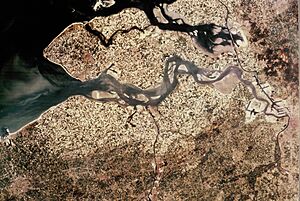Western Scheldt facts for kids
Quick facts for kids
Designations
|
|
| Official name: Westerschelde & Saeftinghe | |
| Designated: | 9 April 1995 |
|---|---|
| Reference #: | 748 |
The Western Scheldt (Dutch: Westerschelde) is a very important waterway in the Netherlands. It is located in the province of Zeeland, in the southwest part of the country. This waterway is actually the mouth, or estuary, of the Scheldt river. An estuary is where a river meets the sea.
Long ago, the Scheldt river had several mouths leading to the sea. But now, the Western Scheldt is the only one still connected to the river. This makes it a super important shipping route. Many ships use it to reach the Port of Antwerp in Belgium.
Unlike another nearby estuary, the Eastern Scheldt, the Western Scheldt could not be closed off with a dam. This was part of a big project called the Delta Works. Instead, the strong walls of land around it, called dykes, were made taller and stronger to protect against floods.
Over many years, a lot of ships have sunk in the Western Scheldt. To make shipping safer and easier for ships going to Antwerp, many of these sunken ships were removed. This happened after an agreement between the Dutch and Belgian governments in 1995. One of the biggest ships removed was the Alan-A-Dale. It was 131 meters (about 430 feet) long. This ship sank in December 1944 during World War II because of a German mini-submarine.
The Western Scheldt area was freed from German control in late 1944. This happened during a big battle called the Battle of the Scheldt, fought by the First Canadian Army.
Recently, people have been trying a new idea called "wisselpolders" or "exchange polders." This is a way to help create new land and make the area safer from floods. It also helps to replace land that has been lost. The Perkpolder project is an example of this idea in action.
Western Scheldt Tunnel
In March 2003, a long tunnel opened under the Western Scheldt. It is called the Western Scheldt Tunnel. This tunnel is about 6.6 kilometers (about 4 miles) long. It connects Ellewoutsdijk in Borsele to Terneuzen in Zeelandic Flanders. It is the longest road tunnel in the Netherlands!
You have to pay a small fee, called a toll, to use the tunnel. In 2012, it cost €5 for cars and €2.50 for motorcycles. Before 2011, motorcycles paid the same as cars, but the price was lowered after some protests. There is only one place to pay the toll, and it's on the north side of the tunnel.
People walking, riding bikes, or mopeds are not allowed in the tunnel. They have to use a bus to travel through it.
Ferry Services
Before the tunnel opened, there were large car ferries that crossed the Western Scheldt. These ferries could carry cars on two levels. When the tunnel opened in 2003, these ferries were sold to companies in Italy. For example, the Queen Beatrix and Prince Johan Friso ferries were renamed and now carry cars between Messina and Villa San Giovanni in Italy.
After the tunnel opened, the ferry service between Breskens and Vlissingen changed. Now, it only carries people walking and cyclists. This ferry is run by Westerschelde Ferry BV. At first, they used the old car ferries for this. But since May 2004, they use two special boats. These boats are called "swaths," which are like catamarans. They were built in Vlissingen and are named Prins Willem Alexander and Prinses Máxima.
Another ferry that used to cross the river, the Kruiningen-Perkpolder ferry, was stopped completely and not replaced.
See also
 In Spanish: Escalda Occidental para niños
In Spanish: Escalda Occidental para niños
- Eastern Scheldt
- Zeeschelde



